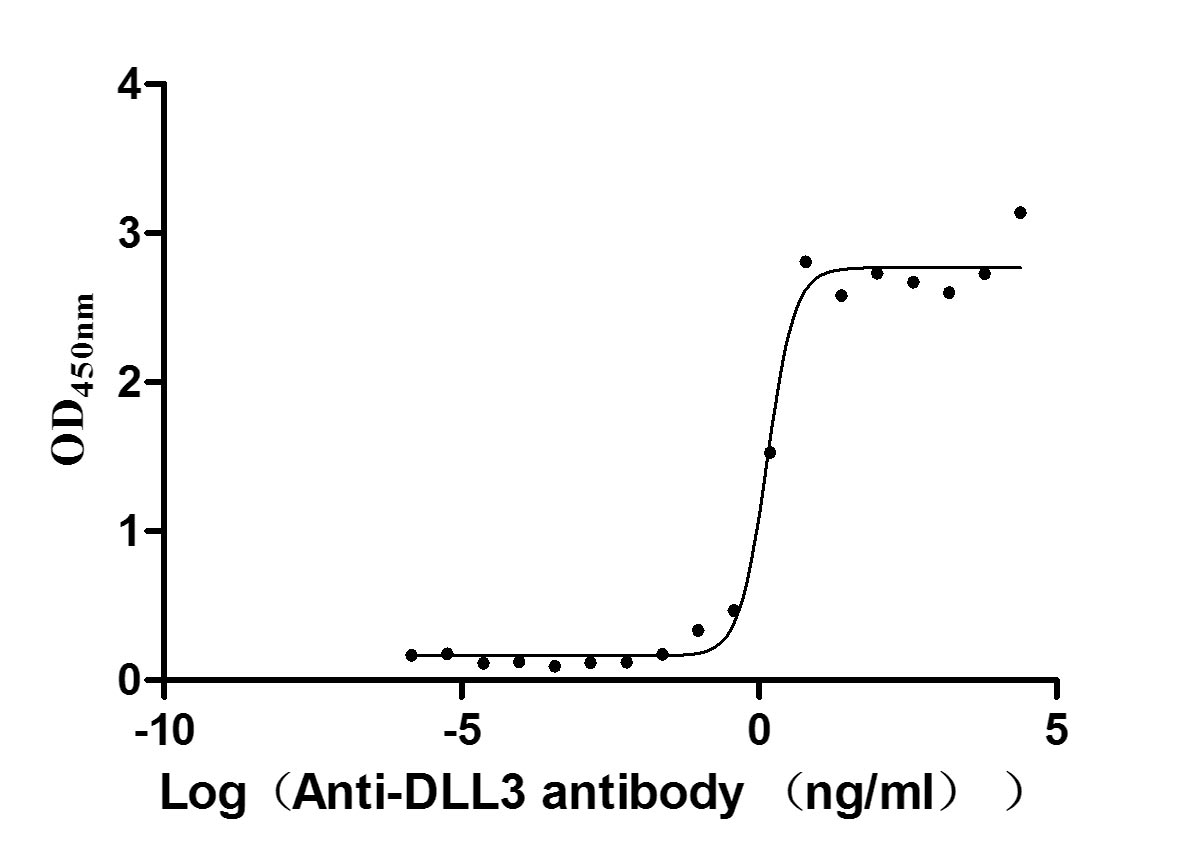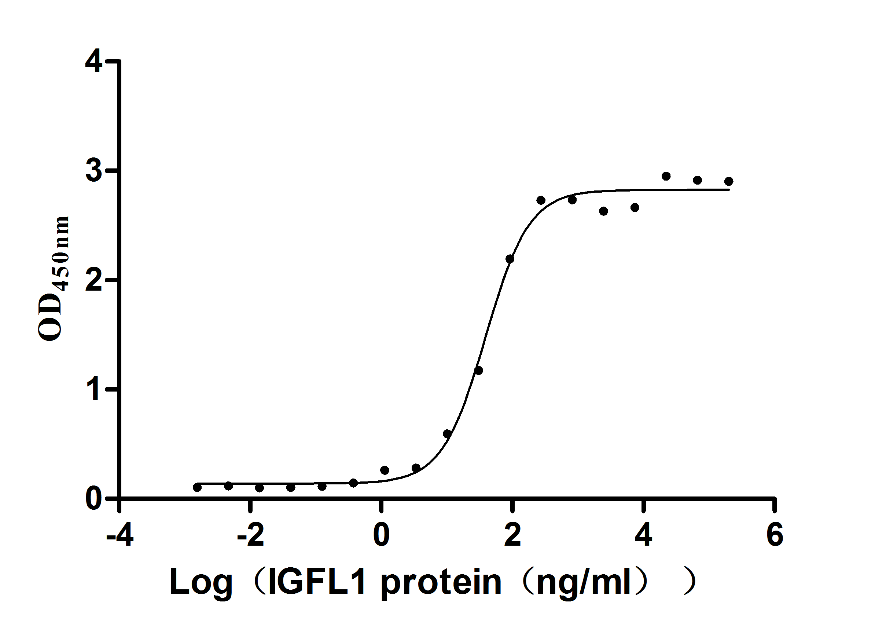Recombinant Human Calcyclin-binding protein (CACYBP)
-
货号:CSB-YP872536HU
-
规格:
-
来源:Yeast
-
其他:
-
货号:CSB-EP872536HU
-
规格:
-
来源:E.coli
-
其他:
-
货号:CSB-EP872536HU-B
-
规格:
-
来源:E.coli
-
共轭:Avi-tag Biotinylated
E. coli biotin ligase (BirA) is highly specific in covalently attaching biotin to the 15 amino acid AviTag peptide. This recombinant protein was biotinylated in vivo by AviTag-BirA technology, which method is BriA catalyzes amide linkage between the biotin and the specific lysine of the AviTag.
-
其他:
-
货号:CSB-BP872536HU
-
规格:
-
来源:Baculovirus
-
其他:
-
货号:CSB-MP872536HU
-
规格:
-
来源:Mammalian cell
-
其他:
产品详情
-
纯度:>85% (SDS-PAGE)
-
基因名:
-
Uniprot No.:
-
别名:CacyBP; Calcyclin binding protein; Calcyclin-binding protein; CYBP_HUMAN; GIG 5; GIG5; Growth inhibiting gene 5; Growth inhibiting gene 5 protein; hCacyBP; MGC87971; PNAS 107; PNAS107; RP1 102G20.6; S100A6 binding protein; S100A6-binding protein; S100A6BP; Siah-interacting protein; SIP
-
种属:Homo sapiens (Human)
-
蛋白长度:Full Length of Mature Protein
-
表达区域:2-228
-
氨基酸序列ASEELQKDL EEVKVLLEKA TRKRVRDALT AEKSKIETEI KNKMQQKSQK KAELLDNEKP AAVVAPITTG YTVKISNYGW DQSDKFVKIY ITLTGVHQVP TENVQVHFTE RSFDLLVKNL NGKSYSMIVN NLLKPISVEG SSKKVKTDTV LILCRKKVEN TRWDYLTQVE KECKEKEKPS YDTETDPSEG LMNVLKKIYE DGDDDMKRTI NKAWVESREK QAKGDTEF
-
蛋白标签:Tag type will be determined during the manufacturing process.
The tag type will be determined during production process. If you have specified tag type, please tell us and we will develop the specified tag preferentially. -
产品提供形式:Lyophilized powder
Note: We will preferentially ship the format that we have in stock, however, if you have any special requirement for the format, please remark your requirement when placing the order, we will prepare according to your demand. -
复溶:We recommend that this vial be briefly centrifuged prior to opening to bring the contents to the bottom. Please reconstitute protein in deionized sterile water to a concentration of 0.1-1.0 mg/mL.We recommend to add 5-50% of glycerol (final concentration) and aliquot for long-term storage at -20℃/-80℃. Our default final concentration of glycerol is 50%. Customers could use it as reference.
-
储存条件:Store at -20°C/-80°C upon receipt, aliquoting is necessary for mutiple use. Avoid repeated freeze-thaw cycles.
-
保质期:The shelf life is related to many factors, storage state, buffer ingredients, storage temperature and the stability of the protein itself.
Generally, the shelf life of liquid form is 6 months at -20°C/-80°C. The shelf life of lyophilized form is 12 months at -20°C/-80°C. -
货期:Delivery time may differ from different purchasing way or location, please kindly consult your local distributors for specific delivery time.Note: All of our proteins are default shipped with normal blue ice packs, if you request to ship with dry ice, please communicate with us in advance and extra fees will be charged.
-
注意事项:Repeated freezing and thawing is not recommended. Store working aliquots at 4°C for up to one week.
-
Datasheet :Please contact us to get it.
相关产品
靶点详情
-
功能:May be involved in calcium-dependent ubiquitination and subsequent proteasomal degradation of target proteins. Probably serves as a molecular bridge in ubiquitin E3 complexes. Participates in the ubiquitin-mediated degradation of beta-catenin (CTNNB1).
-
基因功能参考文献:
- CacyBP expression is regulated by E2F1, EGR1, and CREB transcription factors in colorectal cancer HCT116 cells. PMID: 29197151
- Results suggest that CacyBP/SIP plays an important role in inhibiting glioma cell migration and invasion through promoting the degradation of cytoplasmic p27. PMID: 29024247
- Data show that S100 calcium binding protein A6 (S100A6) is required for the Ca2+-dependent nuclear translocation of calcyclin binding protein (CacyBP/SIP) in colon cancer SW480 cells. PMID: 29534068
- CacyBP/SIP nuclear localization, dependent on S100 protein, suppresses gastric cancer tumorigenesis through beta-catenin degradation and the dephosphorylation of ERK1/2 during the G2 phase. PMID: 29099417
- Our data have shown for the first time the regulation of CacyBP/SIP gene expression by NFAT1. Since NFAT transcription factors are involved in processes related to immune response, these results indicate potential involvement of CacyBP/SIP in the immune system. PMID: 28526484
- These results suggest that CacyBP/SIP may be promoting growth of colon cancer cells by enhancing ubiquitin-mediated degradation of p27kip1. PMID: 28196083
- The biological characteristics and target proteins of CacyBP/SIP and its exact role in various cancers are discussed. Review. PMID: 26873490
- CacyBP/SIP nuclear translocation contributes to the proliferation of gastric cancer cells, and CacyBP/SIP exerts this effect, at least in part, by stimulating ubiquitin-mediated degradation of p27Kip1. PMID: 27099442
- CacyBP/SIP plays an important role in inhibiting apoptosis of glioma cells which might be mediated by ERK1/2 signaling pathway. PMID: 26825673
- CacyBP/SIP is a useful indicator of dis processes in Chronic Lymphocytic Leukemia (CLL) and plays an important role in sustaining the balance of cell proliferation and apoptosis. PMID: 26603518
- CacyBP/SIP nuclear translocation promotes the proliferation and cell cycle progression of gastric cancer cells. PMID: 25110433
- Overexpression of CacyBP is associated with glioma. PMID: 24740456
- This study presents CacyBP as a promising candidate biomarker for colorectal cancer (CRC) metastasis and also sheds light on the underlying molecular mechanism by which CacyBP promotes CRC metastasis. PMID: 23543800
- CacyBP enhances multidrug resistance of pancreatic cancer cells by regulation of P-gp and Bcl-2. PMID: 23463283
- These findings reveal a novel function for SNRK in the regulation of colon cancer cell proliferation and beta-catenin signaling. PMID: 22874833
- different activity of CacyBP/SIP in neuroblastoma NB2a and colon cancer HCT116 cells might affect the ERK1/2 pathway in the differentiation or proliferation processes PMID: 22480271
- new insight into the interaction between S100 proteins and CacyBP/SIP PMID: 22295074
- Data show that CacyBP/SIP might develop into another possible therapeutic target. PMID: 21268134
- Poor cellular differentiation, lymph node invasion, and clinicopathological staging in breast cancer were associated with CacyBP/SIP expression. PMID: 20585948
- CacyBP/SIP exhibits a phosphatase activity toward ERK1/2 kinases while its E217K mutant does not. PMID: 21110948
- CACYBP is associated with acute lung injury in mice PMID: 21297076
- CacyBP regulation of COX-2 expression may play an important role in human breast carcinogenesis PMID: 20878073
- investigation of interaction with Siah1 PMID: 12421809
- the translocation of CacyBP during the retinoic acid-induced differentiation of neuroblastoma SH-SY5Y cells suggested that this protein might play a role in neuronal differentiation PMID: 12895292
- SIP engages Siah1 by means of two elements, both of which are required for mediating beta-catenin destruction in cells PMID: 16085652
- Taken together, our work showed that CacyBP/SIP, as a novel down-regulated gene in renal cell carcinoma, suppressed proliferation and tumorigenesis of renal cancer cells. PMID: 17400182
- CacyBP/SIP may be a potential inhibitor of cell growth and invasion in the gastric cancer cell, at least in part through the effect on beta-catenin protein expression and transcriptional activation of Tcf/LEF PMID: 18171983
- The first study on the CacyBP/SIP expression pattern in a broad range of human normal and tumor tissues. PMID: 18443365
- CacyBP/SIP protein might play an important role in the process of pancreatic carcinogenesis and high-level CacyBP/SIP expression might be related to the malignant potential of pancreatic cancer. PMID: 18765951
显示更多
收起更多
-
亚细胞定位:Nucleus. Cytoplasm. Note=Cytoplasmic at low calcium concentrations. In neuroblastoma cells, after a retinoic acid (RA) induction and calcium increase, it localizes in both the nucleus and cytoplasm. The nuclear fraction may be phosphorylated.
-
数据库链接:
HGNC: 30423
OMIM: 606186
KEGG: hsa:27101
STRING: 9606.ENSP00000356652
UniGene: Hs.508524
Most popular with customers
-
Recombinant Human Delta-like protein 3 (DLL3), partial (Active)
Express system: Mammalian cell
Species: Homo sapiens (Human)
-
Recombinant Human IGF-like family receptor 1 (IGFLR1), partial (Active)
Express system: Mammalian cell
Species: Homo sapiens (Human)
-
Recombinant Human Signal transducer CD24 (CD24)-Nanoparticle (Active)
Express system: Mammalian cell
Species: Homo sapiens (Human)
-
Recombinant Human R-spondin-1 (RSPO1), partial (Active)
Express system: Mammalian cell
Species: Homo sapiens (Human)
-
Recombinant Macaca mulatta Semaphorin-4D isoform 1 (SEMA4D), partial (Active)
Express system: Mammalian cell
Species: Macaca mulatta (Rhesus macaque)
-
Recombinant Human V-set and immunoglobulin domain-containing protein 4 (VSIG4), partial (Active)
Express system: Mammalian cell
Species: Homo sapiens (Human)
-
Recombinant Mouse CUB domain-containing protein 1 (Cdcp1), partial (Active)
Express system: Mammalian cell
Species: Mus musculus (Mouse)
-
Recombinant Macaca fascicularis CUB domain containing protein 1 (CDCP1), partial (Active)
Express system: Mammalian cell
Species: Macaca fascicularis (Crab-eating macaque) (Cynomolgus monkey)




















